Transmission and Signaling Planes
3.2 Transmission and Signaling Planes
3.2.1 Transmission Plane
The transmission plane consists of a layered protocol structure providing user data transfer, along with associated procedures that control the information transfer such as flow control, error detection, and error correction. Figure 3.2 illustrates the layered protocol structure between the MS and the GGSN.
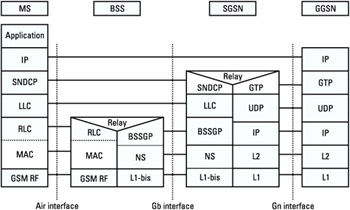 Figure 3.2: Transmission plane MS-GGSN.
Figure 3.2: Transmission plane MS-GGSN.
3.2.1.1 Air Interface
The air interface is located between the MS and the BSS. The protocols used on the air interface are as follows:
-
Radio link control/medium access control (RLC/MAC). RLC provides a reliable radio link between the mobile and the BSS. MAC controls the access signaling procedures to the GPRS radio channel, and the multiplexing of signaling and RLC blocks from different users onto the GSM physical channel.
-
GSM-RF layer. It is the radio subsystem that supports a certain number of logical channels. This layer is split into two sublayers: the radio frequency layer (RFL), which handles the radio and baseband part (physical channel management, modulation, demodulation, and transmission and reception of radio blocks), and the physical link layer (PLL), which manages control of the RFL (power control, synchronization, measurements, and channel coding/decoding).
A relay function is implemented in the BSS to relay the LLC PDUs between the air interface and the Gb interface.
3.2.1.2 Gb Interface
The Gb interface is located between the SGSN and the BSS. It supports data transfer in the transmission plane. The Gb interface supports the following protocols:
-
BSS GPRS protocol (BSSGP). This layer conveys routing and QoS-related information between the BSS and SGSN.
-
Network service (NS). It transports BSSGP PDUs and is based on a frame relay connection between the BSS and SGSN.
A relay function is implemented in the SGSN to relay the packet data protocol (PDP) PDUs between the Gb and Gn interfaces (IP PDUs in Figure 3.2).
3.2.1.3 Gn/Gp Interface
The Gn interface is located between two GSNs (SGSN or GGSN) within the same PLMN, while the Gp interface is between two GSNs in different PLMNs. The Gn/Gp interface is used for the transfer of packets between the SGSN and the GGSN in the transmission plane.
The Gn/Gp interface supports the following protocols:
-
GPRS tunnelling protocol (GTP). This protocol tunnels user data between the SGSN and GGSN in the GPRS backbone network. GTP operates on top of UDP over IP. The layers L1 and L2 of the Gn interfaces are not specified in the GSM/GPRS standard.
-
User datagram protocol (UDP). It carries GTP packet data units (PDUs) in the GPRS Core Network for protocols that do not need a reliable data link (e.g., IP).
-
Internet protocol (IP). This is the protocol used for routing user data and control signaling within the GPRS backbone network.
3.2.1.4 Interface Between MS and SGSN
This interface supports the following protocols:
-
Subnetwork-dependent convergence protocol (SNDCP). This protocol maps the IP protocol to the underlying network. SNDCP also provides other functions such as compression, segmentation, and multiplexing of network layer messages.
-
Logical link control (LLC). This layer provides a highly reliable logical link that is independent of the underlying radio interface protocols. LLC is also responsible for the GPRS ciphering.
3.2.2 Signaling Plane
The signaling plane consists of protocols for control and support of the transmission plane functions. It controls both the access connections to the GPRS network (e.g., GPRS attach and GPRS detach) and the attributes of an established network access connection (e.g., activation of a PDP address), manages the routing of information for a dedicated network connection in order to support user mobility, adapts network resources depending on the QoS parameters, and provides supplementary services.
3.2.2.1 Between MS and SGSN
Figure 3.3 shows the signaling plane between the MS and the SGSN. This plane is made up of the following protocols:
-
GMM. The GMM protocol supports mobility management functionalities such as GPRS attach, GPRS detach, security, RA update, and location update (see Section 3.5).
-
Session management (SM). The SM protocol supports functionalities such as PDP context activation, PDP context modification, and PDP context deactivation (see Section 3.6).
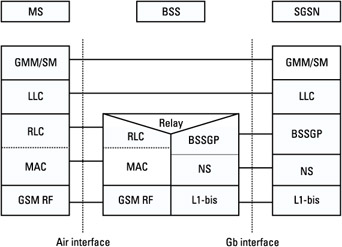
Figure 3.3: Signaling plane MS-SGSN.
3.2.2.2 Between Two GSNs
In the signaling plane, Gn/Gp interfaces are used for the transfer of signaling between the GSNs in the GPRS backbone network. Figure 3.4 shows the signaling plane between two GSNs.
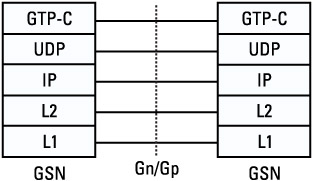
Figure 3.4: Signaling plane GSN-GSN.
The signaling plane between two GSNs is made up of the following protocols:
-
GTP for the control plane (GTP-C). This protocol tunnels signaling messages between SGSNs and GGSNs, and between SGSNs, in the GPRS core network (see Section 3.9).
-
UDP. This protocol transfers signaling messages between GSNs.
3.2.2.3 Interface with Signaling System No. 7
The various GSNs of the GPRS backbone network use a Signaling System No. 7 (SS7) network to exchange information with GSM SS7 network nodes such as HLR, MSC/VLR, EIR, and SMS-GMSC. The SS7 network provides facilities to quickly exchange messages between GPRS backbone network nodes irrespective of data transmission through the GPRS PLMN network.
In the GSM/GPRS backbone network, we found the following protocols for SS7 signaling:
-
Message transfer part (MTP). The three MTP layers allow signaling messages to be exchanged through the SS7 network.
-
Signaling connection control part (SCCP). The SCCP protocol layer allows the service to be used in connected mode and messages to be exchanged between different PLMNs by using an international gateway for SS7 address translation between an SS7 global address (based on the E.164 numbering plan) and an SS7 local address.
-
Transaction capabilities application part (TCAP). The TCAP protocol layer allows dialogs to be structured in an independent manner from any application.
-
Mobile application part (MAP). The MAP protocol layer allows mobile mobility to be managed within different equipment nodes of the NSS across SS7 networks.
As new equipment nodes have been introduced in GSM networks to support the GPRS feature, new interfaces were defined with the HLR, MSC/VLR, EIR, and SMS-GMSC. Table 3.1 lists the new interfaces with SS7 network.
|
Interface Name |
Localization |
Mandatory/Optional |
|---|---|---|
|
Gr |
SGSN-HLR |
Mandatory |
|
Gc |
GGSN-HLR |
Optional |
|
Gf |
SGSN-EIR |
Optional |
|
Gd |
SGSN-SMS GMSC or SGSN-SMS IWMSC |
Optional |
|
Gs |
SGSN-MSC/VLR |
Optional |
Gr Interface
The Gr interface is defined between the SGSN and HLR. It allows the SGSN to retrieve or update GPRS subscription and GPRS location information in the HLR during location-management or authentication procedures. The MAP protocol has been modified to take into account this interface. Figure 3.5 shows the signaling plane on the Gr interface.
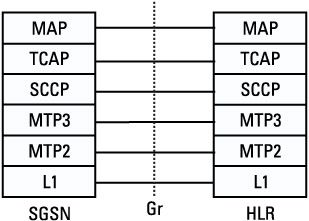
Figure 3.5: Signaling plane on the Gr interface.
Gc Interface
The Gc interface is defined between the GGSN and the HLR. The GGSN contacts the HLR in order to determine the SGSN address where the MS is located and if the MS is reachable. The MAP protocol has been modified to take into account this interface. Figure 3.6 shows the signaling plane on the Gc interface. (Note: If a GGSN does not have a SS7 MAP interface, it will interface to a GSN performing a GTP-MAP protocol-conversion in order to retrieve the needed information from the HLR via the Gc interface.)

Figure 3.6: Signaling plane on the Gc interface.
Gf Interface
The Gf interface is defined between the SGSN and EIR. It is used by the SGSN to contact the EIR database during the identity check procedure. It allows the SGSN to check the IMEI against the EIR. The MAP protocol has been modified to take into account this interface. Figure 3.7 shows the signaling plane on the Gf interface.

Figure 3.7: Signaling plane on the Gf interface.
Gs Interface
The Gs interface is defined between the MSC/VLR and the SGSN. It allows for the coordination of circuit-switched and packet-switched paging in the SGSN as well as location information of any MS attached to both circuit and packet services. This interface is only present in a network that operates in network operation mode I (see definition in Section 3.5.3.1). The BSS application part+ (BSSAP+) allows mobility functionality to be managed on the Gs interface. Figure 3.8 shows the signaling plane on the Gs interface.

Figure 3.8: Signaling plane on the Gs interface.
Gd Interface
The Gd interface is defined between an SGSN and an SMS-GMSC or an SMS-IWMSC. The progress of a short message intended for delivery to an MS requires in circuit and packet modes a gateway function Short Message Service-gateway MSC (SMS-GMSC) between the mobile network and the network that provides access to the SMS center. An SMS to be delivered to an MS is routed from the SMS-GMSC toward the SGSN on the Gd interface if this SMS is to be sent over GPRS.
The progress of a short message originated by the MSs requires in circuit and packet modes a PLMN interworking server SMS-IWMSC (inter-working MSC) that provides access to the SMS center. An SMS originated by an MS is routed from the SGSN toward the SMS-IWMSC on the Gd interface if the SMS is to be sent over GPRS.
The MAP protocol has been updated as a consequence of the signaling exchange between the SGSN and the SMS-GMSC or the SMS-IWMSC. Figure 3.9 shows the signaling plane on the Gd interface.
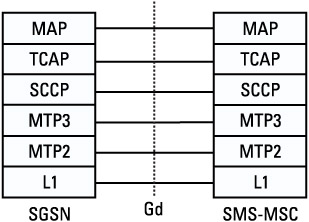
Figure 3.9: Signaling plane on the Gd interface.






